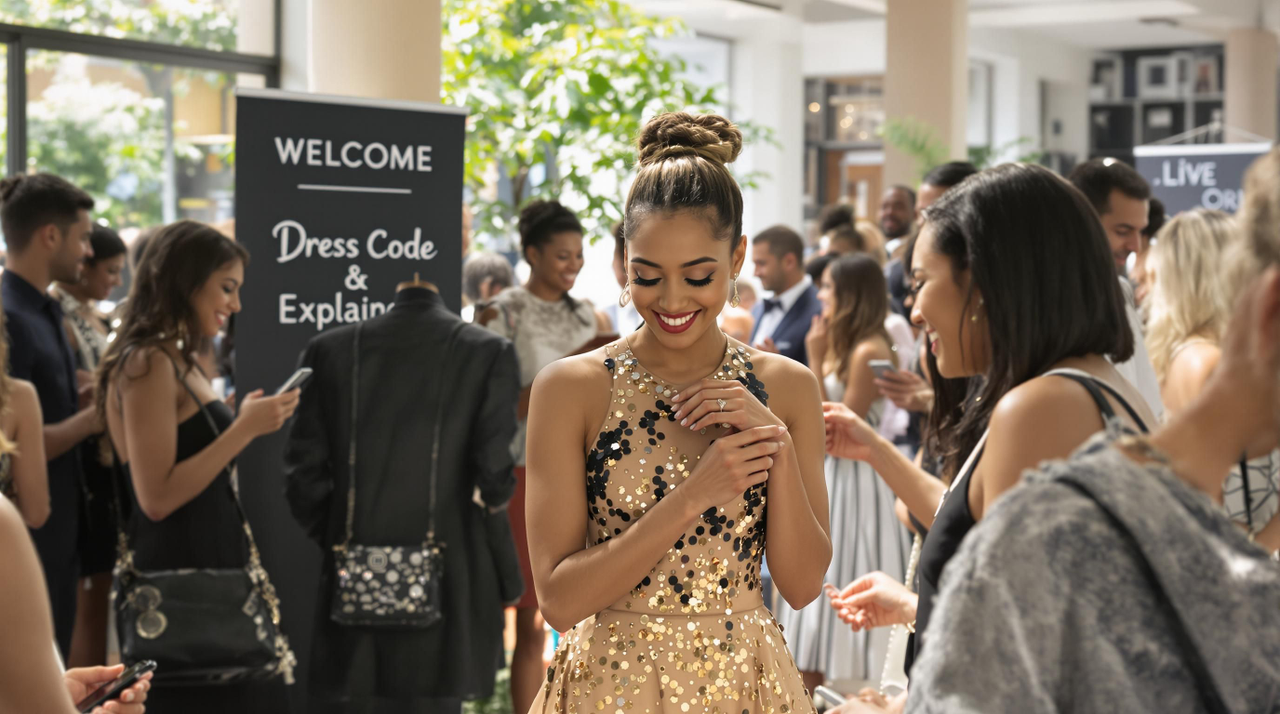Dress Code Explained 2025: A Guide for Special Events
Dress Code Explained 2025: A Guide for Special Events
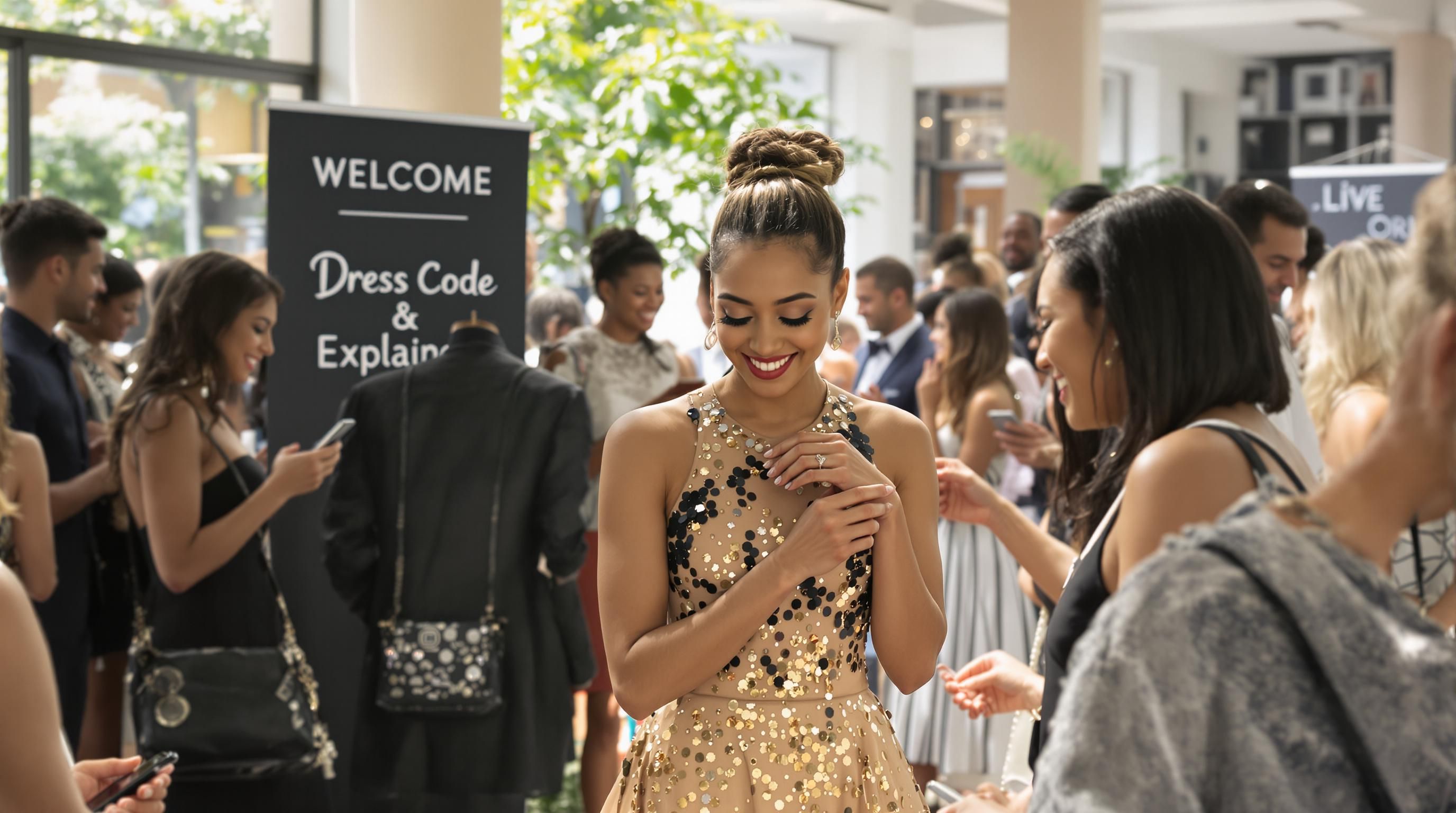
Dress codes sound simple at first but they actually shape the outcome of nearly every big event, from prom nights to elegant weddings. Most people assume it is all about picking the nicest dress in the closet and moving on. Yet almost no one realizes that dress codes for women often include specific requirements about grooming, accessories, and even shoe type—not just the dress itself. This hidden layer of expectations means mastering event attire is less about rules and more about decoding a complicated social puzzle.
Table of Contents
- What Dress Codes Mean For Women
- Understanding Dress Codes At Proms And Weddings
- Fashion Tips For Selecting The Perfect Outfit
- Where To Shop For Designer Event Dresses Online
Quick Summary
| Takeaway | Explanation |
|---|---|
| Understand complex dress codes | Awareness of various dress codes helps navigate social expectations and make informed clothing choices. |
| Embrace personal style | Recognizing your unique style allows for individual expression while adhering to dress code norms. |
| Consider occasions carefully | Each special event has specific attire requirements that reflect cultural and social significance. |
| Research online shopping platforms | Utilize detailed information from reputable online retailers to ensure quality and fit when purchasing dresses. |
| Stay updated with fashion trends | Emerging technologies in online shopping can enhance the purchasing experience and provide better fit. |
What Dress Codes Mean for Women
Dress codes represent more than just clothing guidelines. They are complex social signals that communicate expectations, status, and cultural norms specifically impacting women’s fashion choices and personal expression.
Understanding Social Expectations
Gender-based dress codes establish intricate standards that go beyond simple clothing recommendations. These guidelines often create nuanced expectations for women’s appearance, involving not just attire but also grooming, makeup, and overall presentation. According to workplace research, these codes can disproportionately impact women, transgender, and non-binary individuals by imposing stricter aesthetic requirements.
Women frequently navigate multilayered dress code expectations across different environments. A professional setting might demand business formal attire, while an evening event requires an entirely different approach. The complexity lies in understanding these unwritten rules and interpreting them correctly without compromising personal style or comfort.
Formal Wear Decoded
In the realm of formal events, dress codes become particularly intricate. Formal wear guidelines suggest that women’s most sophisticated attire involves full-length ball gowns or evening dresses. For white tie events, additional expectations emerge, such as wearing long gloves extending past the elbow, signaling ultimate elegance and adherence to traditional social protocols.
These dress code expectations are not merely about clothing but communicate social intelligence. Understanding the nuanced differences between black tie, white tie, cocktail, and business formal demonstrates a woman’s social awareness and ability to navigate complex social environments.
Legal and Professional Implications
Workplace dress codes carry significant legal and professional implications for women. Employers must create guidelines that do not discriminate based on gender. This means establishing similar standards for men and women, avoiding unfair requirements like mandatory high heels or overly restrictive clothing choices. Interestingly, professional dress codes must also accommodate religious and cultural variations, ensuring that women can express their identity while maintaining professional standards.
The evolving landscape of dress codes reflects broader societal changes. Modern interpretations increasingly recognize individual expression, moving away from rigid, one-size-fits-all approaches. Women today have more flexibility to interpret dress codes through their personal lens, balancing professional expectations with personal style and comfort.
Ultimately, dress codes for women are a sophisticated language of social communication. They represent a complex interplay between personal expression, professional expectations, and cultural norms. Mastering this language requires understanding context, reading social cues, and confidently expressing one’s identity within established frameworks.
Here is a comparison table summarizing the differences between common formal dress codes and their requirements for women:
| Dress Code Type | Typical Attire | Accessories & Grooming | Key Social Expectation |
|---|---|---|---|
| White Tie | Full-length ball gown | Long gloves, elegant updo | Ultimate formality, tradition |
| Black Tie | Floor-length or formal dress | Statement jewelry, heels | Sophistication, elegance |
| Cocktail | Knee-length/semi-formal dress | Creative accessories, clutch | Stylish, semi-formal confidence |
| Business Formal | Conservative suit/dress | Minimal jewelry, neat grooming | Professionalism, authority |
Understanding Dress Codes at Proms and Weddings
Prom and wedding dress codes represent critical milestones in personal style expression, each carrying unique social expectations and cultural significance. These events demand careful navigation of fashion protocols that blend personal identity with traditional guidelines.
Prom Dress Code Dynamics
Britannica highlights prom as a significant rite of passage in American high school culture, where dress codes serve as more than mere clothing guidelines. These events represent complex social interactions where attire communicates personal identity, social status, and individual creativity. Quartz research reveals that prom dresses are not just garments but powerful statements of emerging personal autonomy.
Typical prom dress codes range from semi-formal to formal, with variations depending on school traditions and event themes. Students must interpret these guidelines while expressing their unique style. Some schools provide specific color recommendations or length requirements, adding another layer of complexity to dress selection. For those seeking elegant prom dress options, understanding these nuanced expectations becomes crucial.
Wedding Attire Protocols
Vogue’s comprehensive dress code guide provides essential insights into wedding attire expectations. Wedding dress codes represent a sophisticated spectrum from casual to ultra-formal, each carrying specific expectations. Black tie events demand floor-length gowns, while cocktail attire allows for more creative interpretations of semi-formal wear.
Guests must carefully consider the invitation’s specified dress code, which often reflects the couple’s wedding style and venue. An outdoor beach wedding might permit more relaxed attire, whereas a cathedral ceremony requires strict adherence to formal dress protocols. Understanding these distinctions prevents potential social embarrassment and demonstrates respect for the event’s significance.
To help clarify the attire differences, the following table summarizes typical dress code requirements for proms and weddings:
| Event Type | Dress Code Level | Typical Attire | Special Considerations |
|---|---|---|---|
| Prom | Semi-Formal/Formal | Evening dress, gown | School traditions, color/length |
| Wedding (Black Tie) | Formal | Floor-length gown | Follows couple’s theme, venue |
| Wedding (Cocktail) | Semi-Formal | Knee-length or midi dress | Creative styling allowed |
| Wedding (Beach/Casual) | Casual/Relaxed | Sundress, light fabrics | Weather, outdoor setting |
| Wedding (Cathedral) | Ultra-Formal | Full-length, conservative gown | Tradition, covered shoulders |
Navigating Social Expectations
Both prom and wedding dress codes serve as intricate social languages. They communicate respect, understanding of cultural norms, and personal style sophistication. Young women must balance individual expression with event-specific expectations, a skill that extends far beyond these specific occasions.
Modern dress codes increasingly embrace personal interpretation, allowing more flexibility in traditional guidelines. This evolution reflects broader societal shifts towards individual expression while maintaining fundamental respect for event traditions. Successfully navigating these dress codes requires a nuanced understanding of context, social signals, and personal confidence.
Ultimately, mastering dress codes for proms and weddings is about more than selecting the right outfit. It is an art form that blends personal style, social intelligence, and cultural awareness. Each event presents an opportunity to communicate identity through carefully chosen attire, making dress selection a deeply personal and meaningful experience.
Fashion Tips for Selecting the Perfect Outfit
Selecting the perfect outfit transcends mere clothing selection. It is an art form that combines personal style, body awareness, and contextual understanding, transforming individual pieces into a cohesive fashion statement.
Understanding Personal Style
Fashion experts emphasize the importance of recognizing your unique personal style as the foundation of exceptional outfit creation. This involves understanding whether your aesthetic leans towards casual, classic, bohemian, or edgy expressions. Developing a keen sense of personal style requires exploring various inspirations from fashion magazines, social media, and style icons that resonate with your individual personality.
Body shape plays a critical role in outfit selection. Different silhouettes flatter various body types, making it essential to choose clothing that highlights your strengths. For instance, pear-shaped bodies benefit from tops that accentuate shoulders, while apple-shaped figures look stunning in empire-cut designs that draw attention to legs. The key is creating visual balance and proportion that makes you feel confident and comfortable.
Strategic Layering and Versatility
Woman & Home provides expert insights into the art of layering, a technique that maximizes wardrobe versatility. Strategic layering allows transforming a single dress across multiple occasions and seasons. Blazers can elevate a simple t-shirt dress for smart-casual settings, while cropped jackets beautifully complement fit-and-flare styles by accentuating the waistline.
The most successful layering techniques focus on proportion and balance. Lightweight cotton shirts, colorful prints, and tailored jackets can redefine existing wardrobe pieces sustainably. Trench coats work wonderfully with sleeveless dresses, and boucle jackets offer elegant transformations. When selecting layer pieces, prioritize comfort and visual harmony, ensuring each additional element enhances rather than overwhelms your primary outfit.
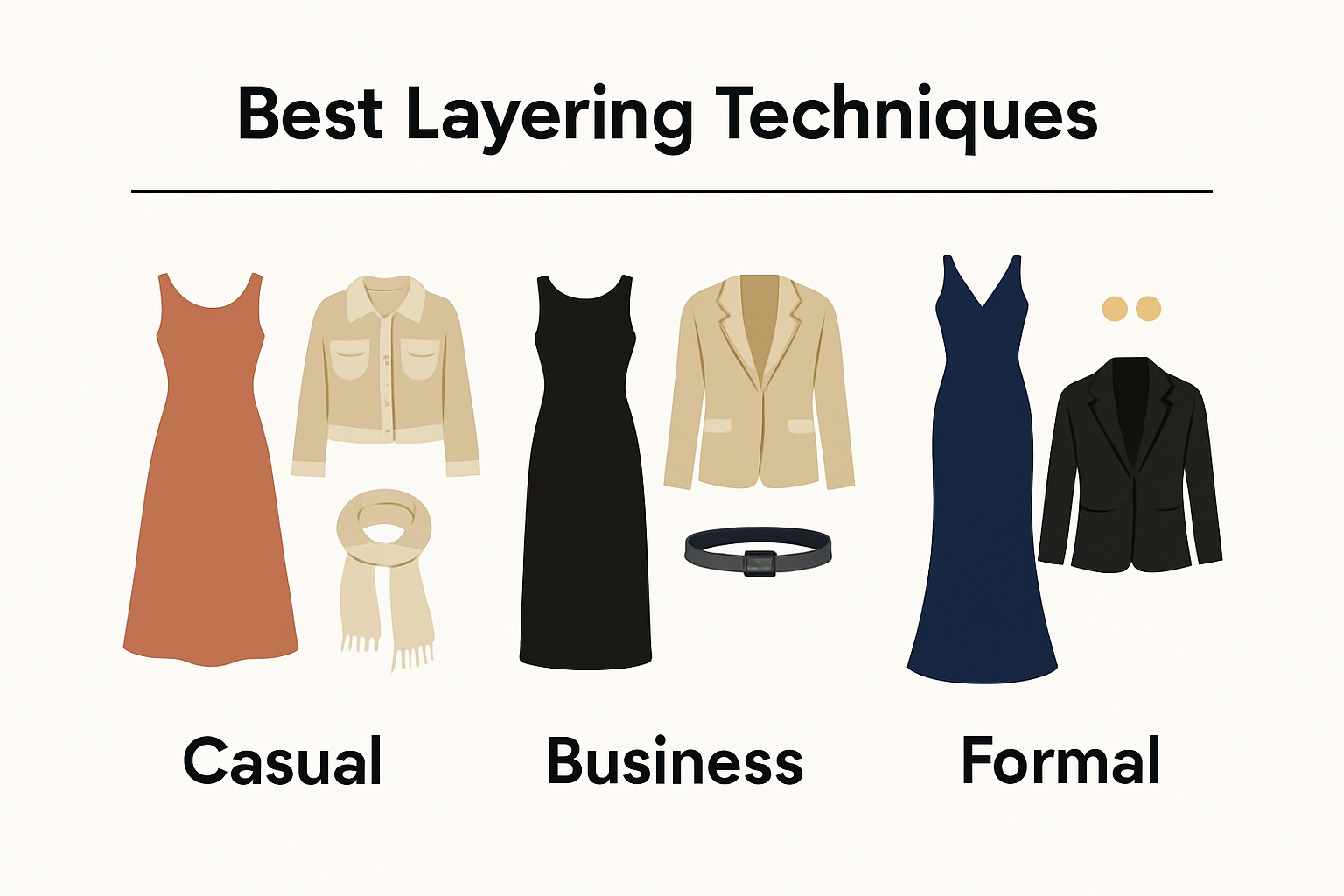
Occasion-Specific Styling
Gala event styling demonstrates the nuanced approach required for specialized dress codes. Formal events demand careful consideration of fabric, silhouette, and accessorizing. For high-end occasions like galas, opt for dramatic maxi-length dresses or elegant jumpsuits in luxurious materials such as satin, velvet, or sequins.
Color selection and accessorizing are crucial. Jewel tones and metallics create sophisticated looks, while minimal yet statement jewelry elevates an outfit. Choose sleek clutches over large bags, and ensure outerwear matches the event’s formality. Comfortable yet stylish heels complete the ensemble, allowing you to navigate social settings with grace and confidence.
Beyond technical considerations, the most important element of outfit selection is personal confidence. Wear each carefully curated look with assurance, understanding that true style emerges from the intersection of external presentation and internal self-expression. Fashion is not about following rigid rules but about creating a visual narrative that authentically represents your unique personality.
Where to Shop for Designer Event Dresses Online
Navigating the digital landscape of online designer dress shopping requires strategic approach, understanding of quality indicators, and awareness of emerging fashion platforms that offer exceptional event wear selections.
Research and Verification Strategies
Library of Congress resources emphasize the importance of comprehensive research when exploring online fashion platforms. Reputable online designer dress retailers should offer detailed sizing charts, high-resolution images from multiple angles, fabric composition descriptions, and transparent return policies. Before making a purchase, examine customer reviews, understand the designer’s background, and verify the authenticity of the garments.
Research platforms like the Berg Fashion Library can provide additional context about designer collections and fashion trends. These academic resources help shoppers understand the historical and contemporary significance of specific designer collections, enabling more informed purchasing decisions.
Evaluating Online Designer Dress Platforms
When shopping for designer event dresses, consider platforms that offer comprehensive visual and technical information. Key evaluation criteria include:
- Detailed Size Guidance: Accurate measurement instructions and inclusive size ranges
- Fabric Quality Descriptions: Precise material composition and care instructions
- High-Resolution Imagery: Multiple view angles and zoom capabilities
- Transparent Pricing: Clear cost breakdown including potential alterations
- Secure Payment Options: Multiple verified payment methods
Additionally, look for platforms that provide styling consultations, virtual try-on technologies, or personalized recommendation systems. These features can significantly enhance the online shopping experience, helping you select the perfect dress for your specific event.
Emerging Online Shopping Trends
The American University of Paris highlights the evolving digital fashion landscape, where artificial intelligence and advanced visualization technologies are transforming online dress shopping. Emerging trends include:
- Virtual fitting rooms that use body scanning technology
- AI-powered style recommendation engines
- Augmented reality dress visualization platforms
- Sustainable and ethical designer collections
- Customization and made-to-measure online services
These technological advancements are making online designer dress shopping more accessible, personalized, and user-friendly. Consumers can now experience near-physical shopping interactions through digital platforms, reducing uncertainty and increasing confidence in their online purchases.
Successful online designer dress shopping requires a blend of technological savvy, fashion knowledge, and careful research. By understanding platform capabilities, leveraging digital resources, and maintaining a discerning eye, shoppers can discover exceptional event wear that perfectly matches their style, body type, and occasion requirements. The key is to approach online shopping as an informed, strategic consumer who values quality, authenticity, and personal expression.
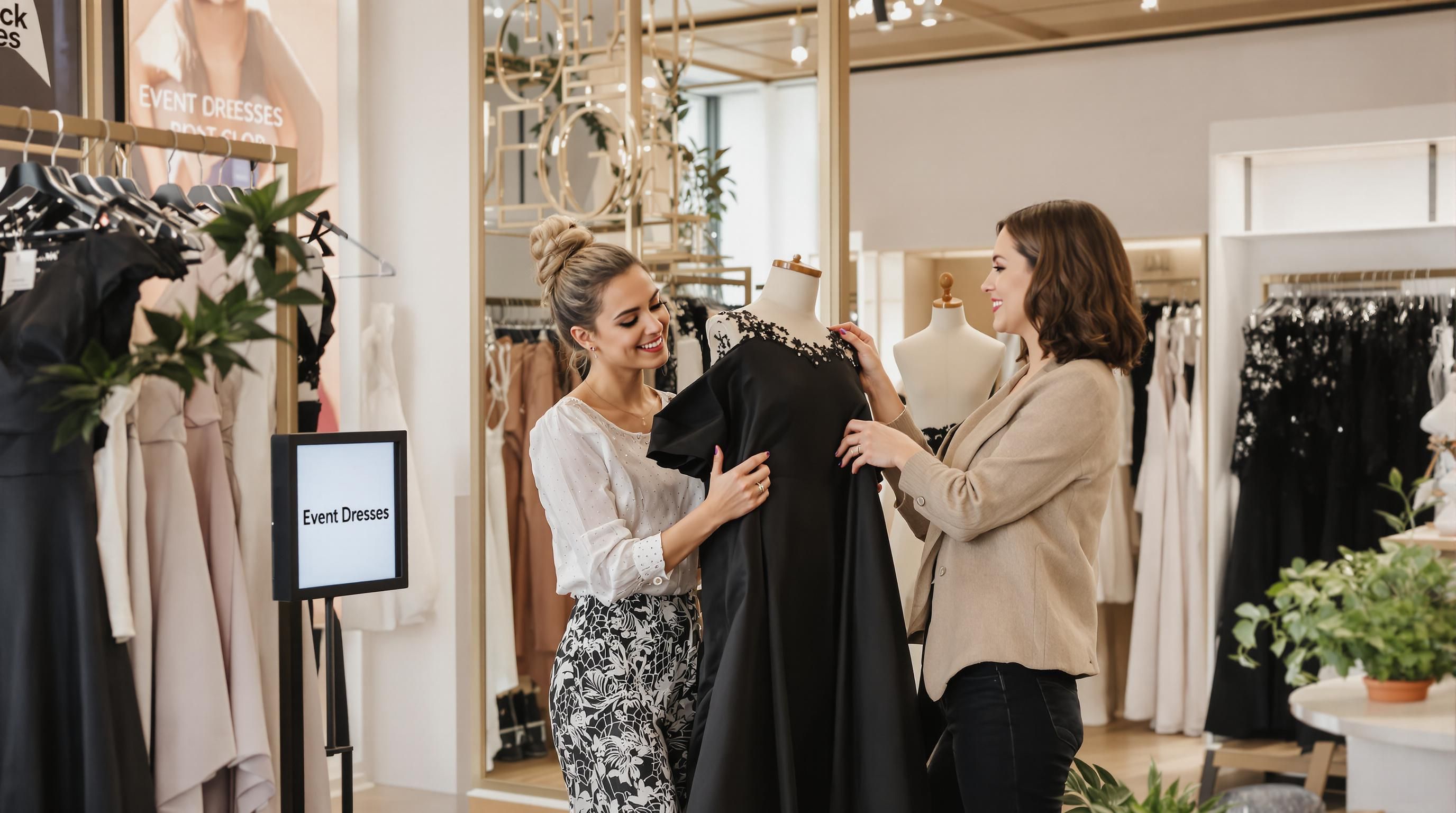
Frequently Asked Questions
What are common dress codes for special events?
Common dress codes include White Tie, Black Tie, Cocktail, and Business Formal. Each has specific attire requirements ranging from full-length gowns for White Tie to conservative suits for Business Formal.
How do I choose the right outfit for a wedding?
When choosing an outfit for a wedding, consider the dress code specified in the invitation. Options range from formal dresses for Black Tie affairs to lighter, more casual attire for beach or outdoor weddings.
What should I consider when shopping for event dresses online?
When shopping online for event dresses, look for detailed sizing information, fabric quality descriptions, high-resolution images, and transparent return policies. Research customer reviews and the retailer’s credibility before making a purchase.
How do dress codes differ between proms and weddings?
Prom dress codes often allow for more personal expression and creativity, typically ranging from semi-formal to formal. In contrast, wedding dress codes are usually more structured, reflecting the couple’s preferences and the event’s formality.
Find the Right Dress Code Solution for Every Special Occasion
Trying to decode complicated event dress codes can leave anyone feeling overwhelmed. This article explained how easy it is to miss subtle requirements like fabric choice, length, or even accessory rules for occasions such as proms and weddings. Many women worry about showing up underdressed, out of place, or simply not fitting in at big events. If you want to skip the guesswork and feel confident choosing exactly the right look, a better option is within reach.
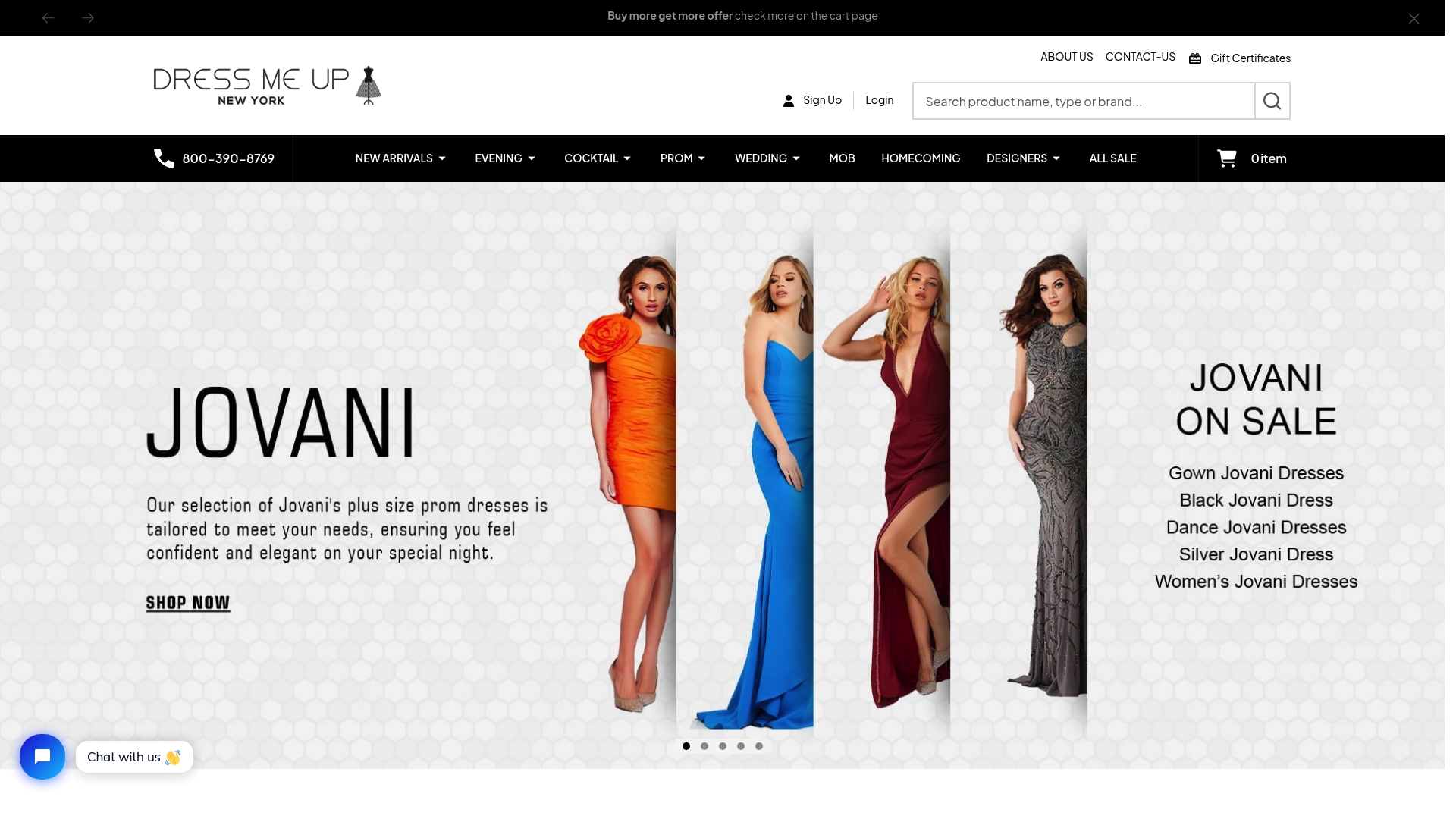
Visit Dress Me Up NY to see curated collections designed around every event’s unique dress code needs. Our store makes it simple to browse by event, trend, or occasion, ensuring you never have to second-guess your choice. Ready for your next formal event? Start exploring the latest evening gowns and stylish prom dresses to find your perfect fit today. Do not let dress codes hold you back—discover a new level of confidence and elegance for every milestone moment.
Recommended
- Alyce Paris 1771 Metallic Jacquard Sleeveless Formal Dress
- Jovani 09739 Sleeveless Deep V-Neck Fitted Short Dress
- Shop Alyce Paris 61418 Lace-Tulle Scoop Neck Sleeveless Dress
- Dancing Queen 1746 V-neck Strap Sleeve Quinceanera Gown

